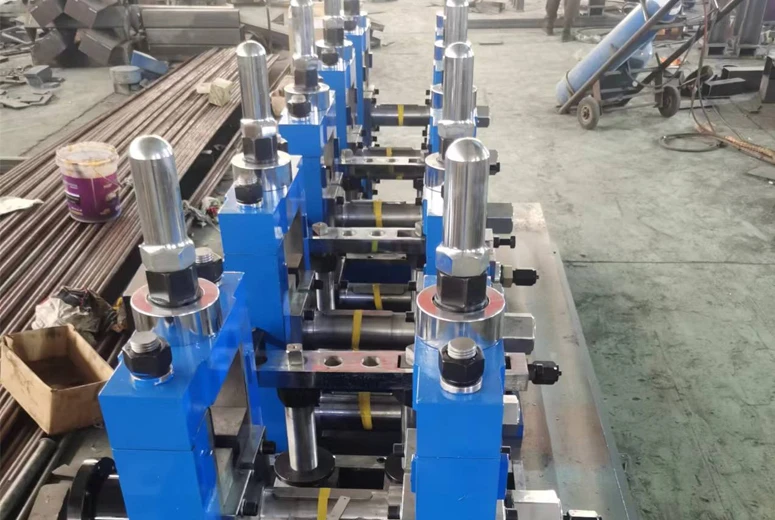Angle Steel Roll Forming Equipment for Efficient Structural Fabrication Processes
Understanding Angle Steel Roll Forming Machines
Angle steel, also known as angle iron, is a common structural element used in construction, manufacturing, and engineering applications. The demand for angle steel products has risen significantly due to their versatility and strength, making the process of producing these materials efficient and cost-effective essential. One of the critical technologies for manufacturing angle steel is the angle steel roll forming machine. This article explores the workings, advantages, applications, and considerations of using angle steel roll forming machines in industrial operations.
What is an Angle Steel Roll Forming Machine?
An angle steel roll forming machine is a specialized piece of equipment designed to shape and form steel into angular profiles. This machine operates using a series of rollers, each progressively bending the steel strip into the desired angle configuration as it passes through the machine. Typically, the machine supports the formation of various sizes and thicknesses of angle steel, thereby allowing manufacturers to create customized solutions for different applications.
How Does it Work?
The process of roll forming begins with a coil of steel that is unwound and fed into the rollers. The rollers can be adjusted to achieve different angles and widths, which results in the production of specific angle steel sections. The steel strip is continuously fed through the series of rollers, each applying incremental pressure until the desired shape is achieved.
1. Unwinding The steel coil is placed on an uncoiler, allowing it to unwind smoothly. 2. Feeding The steel material is fed into the machine where it is guided into the first roller. 3. Forming As the steel moves through multiple sets of rollers, it is gradually bent into its final shape. 4. Cutting Once the desired length of the angle steel is formed, an automatic cutting mechanism trims the section to size. 5. Finishing Additional processes may be employed, such as surface treatment or galvanizing, to enhance durability and corrosion resistance.
Advantages of Using Angle Steel Roll Forming Machines
1. High Efficiency The roll forming process allows for continuous production, reducing labor costs and increasing output. This efficiency is particularly advantageous for large-scale operations that require high volumes of angle steel. 2. Precision The machine can produce consistent shapes and dimensions, ensuring products meet tight tolerances and standards.
3. Flexibility Many roll forming machines are adaptable, allowing manufacturers to change the design settings quickly to accommodate different specifications without extensive downtime.
4. Material Utilization Roll forming generates minimal waste, as the process is designed for continuous production, maximizing the use of raw materials.
angle steel roll forming machine

Applications of Angle Steel
Angle steel is widely used across various industries due to its strength and versatility. Common applications include
- Construction Angle steel is a fundamental component in building frameworks, providing structural support for buildings, bridges, and other infrastructure. - Manufacturing It is utilized in manufacturing machinery and equipment, often found in the frames and supports of industrial machines. - Automotive In the automotive sector, angle steel is used in vehicle frames and structural reinforcements. - Furniture The furniture industry also employs angle steel in the production of sturdy and durable furniture frames.
Considerations When Choosing a Roll Forming Machine
When selecting an angle steel roll forming machine, several factors should be taken into account
1. Production Capacity Assess the volume of production required to meet demand. Choose a machine that can handle the expected output without frequent interruptions.
2. Material Specifications Ensure the machine can accommodate the thickness and types of materials you plan to utilize.
3. Customization Look for machines that offer flexibility in changing profiles, as this allows for the adaptability needed to respond to market changes.
4. Technical Support Opt for manufacturers that provide robust technical support and maintenance services to ensure optimal machine performance.
5. Cost Consider the overall cost of ownership, including initial investment, operation costs, and maintenance.
In conclusion, angle steel roll forming machines represent a vital technology in the production of angle steel, delivering high efficiency, accuracy, and flexibility. As industries continue to evolve and demand for steel products increases, investing in advanced roll forming technology will be crucial for manufacturers looking to maintain competitiveness and meet market demands.
-
High Frequency Straight Seam Welded Pipe Production Line-BzZhou Xinghua Machinery Equipment Manufacturing Co., LTD.|Precision Welding, High EfficiencyNewsJul.30,2025
-
High Frequency Straight Seam Welded Pipe Production Line|BzZhou Xinghua|Precision Welding&EfficiencyNewsJul.30,2025
-
High Frequency Straight Seam Welded Pipe Production Line - BzZhou Xinghua|Precision Engineering&EfficiencyNewsJul.30,2025
-
High-Frequency Straight Seam Welded Pipe Production Line-BzZhou Xinghua Machinery Equipment Manufacturing Co., LTD.NewsJul.30,2025
-
High-Frequency Straight Seam Welded Pipe Production Line-BzZhou Xinghua Machinery Equipment Manufacturing Co., LTD.|Precision Manufacturing, High EfficiencyNewsJul.30,2025
-
High Frequency Straight Seam Welded Pipe Production Line-BzZhou Xinghua Machinery Equipment Manufacturing Co., LTD.|Precision Steel Pipe Manufacturing&Industrial EfficiencyNewsJul.29,2025


